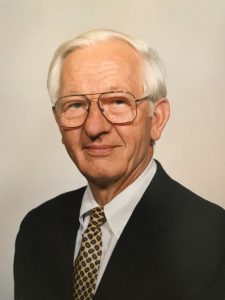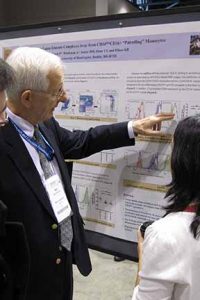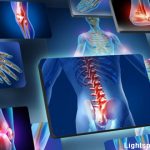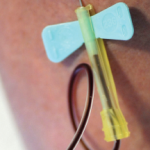Mart Mannik, MD, professor emeritus, Division of Rheumatology at the University of Washington (UW), passed away on Wednesday, Aug. 22, 2018.
Dr. Mannik was born in Estonia and came to the U.S. at age 12 as a refugee from World War II. He received his medical degree from Western Reserve University School of Medicine in Cleveland. His post-graduate training included residency training at Massachusetts General Hospital in Boston, a guest investigator position in the laboratory of Henry Kunkel at Rockefeller University in New York and a clinical associate position at the National Institute of Arthritis and Metabolic Diseases, Rheumatology, Bethesda.
During the 34 years he served as division head at UW, Dr. Mannik made a major impact. Under his leadership, the number of faculty increased from two to 12, and UW faculty led research initiatives in gout, rheumatoid arthritis (RA), systemic lupus erythematosus (SLE) and associated diseases.
He played a commanding role in shaping rheumatology practice in the Northwest U.S. As the program director and primary investigator for an NIH-supported research training grant in rheumatology, Dr. Mannik supervised or personally trained more than 100 rheumatologists, some of whom subsequently became division heads at other institutions.
One of those leaders, Richard Pope, MD, the Solovy/Arthritis Research Society Professor of Medicine (Rheumatology) at Northwestern University, says, “Over the two years of my fellowship, Mart taught me lessons on how to approach research that have served me well throughout my career: how to ask the over-riding question, to develop hypotheses, to set up experiments to address the hypotheses, to perform the experiments, to analyze the data and how to put it all together. Along with David Teller from the Department of Chemistry, we characterized the molecular mechanism for self-association of IgG rheumatoid factor.
“I have always been thankful to Mart for the way he formed my research career,” Dr. Pope continues. “As chief of the Division of Rheumatology at Northwestern University for 27 years, I imparted these same approaches to my colleagues who were in the forefront of the new focus on clinic research in rheumatology. Their skills were developed through a P60 center grant, which we had for over 25 years, even after I stepped down. Today, many successful investigators in clinical, translational and basic research focused on rheumatology have benefitted from the lessons taught by Mart. His legacy continues to be passed on by today’s leaders.”
Through his leadership roles at UW, the Western Society for Clinical Investigation and the Northwest Rheumatism Association, as well as activities at the local Arthritis Foundation, Dr. Mannik helped transform the Northwest U.S. from a place with low awareness and skills in rheumatic disorders to a stronghold of high-quality clinical care and outstanding basic rheumatologic investigation.
Dr. Mannik’s scientific achievements were exceptional. His research career was focused on the role of immune complexes in rheumatic diseases, particularly RA and SLE. His observations regarding rheumatoid factors, in particular self-associating IgG rheumatoid factor, as a major source of immune complexes in the rheumatoid joint, remain completely original and unchallenged. He received the Lee C. Howley Prize from the Arthritis Foundation in 1988 and the ACR Distinguished Basic Investigator Award in 1997.
Another leader trained by Dr. Mannik, William P. Arend, MD, Distinguished Professor of Medicine Emeritus at the University of Colorado School of Medicine, says, “Mart greatly expanded my horizons and opened my eyes to the beauty of basic science as it applied to the rheumatic diseases. My career in academic medicine was shaped by his intellect and drive. He had previously worked on the structure of the IgG molecule at the Rockefeller Institute, and in Seattle he applied his extensive knowledge of basic immunology to the rheumatic diseases.
“Mart showed me how to think as a scientist,” continues Dr. Arend. “He stimulated my ideas by his sharp thought process and was able to shape my own development by his inquisitive reasoning and questioning. He was working on the mechanism of deposition of soluble immune complexes in the kidneys in SLE. I started on a similar question in RA: What was the nature of soluble immune complexes in the sera of patients in RA, and what was the mechanism of their deposition in the joints? This started me on an extensive series of experiments on the interaction of immune complexes with monocytes and macrophages. We discovered a new form of IL-1, called IL-1 receptor antagonist, that interacted with a single chain IL-1 receptor on cells but failed to bind to a second chain that initiated initiation. In fact, it functioned as an endogenous inhibitor of IL-1 function. Mart’s intellect helped me through the thought process of this question and assisted me in finding the techniques to address it.”
“I fondly remember Mart’s openness and his willingness to discuss issues,” says Dr. Pope. “However, after all the years that have passed, I remember during my formative years wanting him to tell me what to do to address the question of the day. I kept saying to myself, ‘Just tell me what to do, and we can accomplish the goal quickly.’ He never did, he wanted me to think it through and figure it out. That was a lesson that I did not appreciate at the time, but now I understand the wisdom, and am forever grateful.”
“Mart taught me how to write scientifically,” says Dr. Arend. “He read each of my drafts meticulously and marked up my manuscripts extensively. This experience prepared me well for a subsequent job as editor of Arthritis & Rheumatism.”
Mart’s collegiality, his expectations of excellence, and his contributions to medicine and science will long be remembered.
“Dr. Mart Mannik was a superb mentor, leading me to an exciting career of scientific work. I could not have asked for a more capable role model and friend,” says Dr. Arend.
Dr. Pope says, “I remember lunches with Mart and the other fellows in what I believe was the faculty dining room. It was tradition. It was a special time.
“Mart touched my life as a rheumatologist and investigator in a way that I, and I am sure all the others who have trained with him, will cherish and remember,” concludes Dr. Pope.
“Mart was an outstanding clinician-scientist. We will miss him,” says Eng M. Tan, MD, professor emeritus at the Scripps Research Institute.
Dr. Mannik is survived by his wife, Zita, and his brothers, children and grandchildren. An obituary prepared by the family can be found in the Seattle Times. In lieu of sending flowers the family requests that donations be made in his name to the University of Washington Division of Rheumatology.
Keith Elkon, MD, is a professor of medicine and head of the Department of Rheumatology at the University of Washington.




